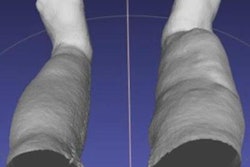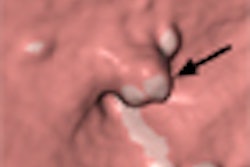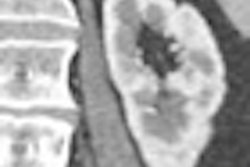Hospitals can save time and money by bringing CT scanners to intensive care patients rather than the other way around, according to a study from the Cleveland Clinic in Ohio. Study authors Dr. Thomas Masaryk and colleagues hailed the reduced personnel utilization and lower risk of scanning the patients bedside with a portable CT scanner.
"CT imaging has become an increasingly valuable diagnostic modality for Intensive Care Unit (ICU) patients, and radiographic findings often significantly impact clinical management," they noted. "However, many clinicians may be reluctant to perform CT imaging on hemodynamically unstable ICU patients, as there are both risks and logistical difficulties associated with the transport of such patients" (Radiology Management, March-April 2008, Vol. 30:2, pp. 2-6).
Staff routinely accompanies ICU patients to the radiology department to complete scans, boosting the cost of care and taking up valuable staff time. Even with such assistance, the risks of transporting the patients are substantial. The authors cited a study by Weissman and colleagues that demonstrated a 13% increase in morbidity associated with transporting ICU patients to the operating room.
In another study, Smith and colleagues from Cooper Hospital and University Medical Center in Camden, NJ, found that adverse events such as disconnection of ventilators and monitoring equipment occurred on a third of all transports outside the ICU in a group of 125 patients. "Transport specifically to the CT suite was associated with a 71% incidence of adverse events," Masaryk and his team wrote of patients transferred within the hospital (Critical Care Medicine, March 1990, Vol. 18:3, pp. 278-281).
"To address concerns for patient safety, resident physicians, nurses, and respiratory therapists accompany ICU patients during transport," Masaryk and his team wrote. "As many as five staff members may be required for transport, and the nurse-to-patient ratio in the ICU may increase from 2:1 to 2.5:1 as a consequence."
An initial assessment of the number and types of scans performed on ICU patients showed that 1,700 scans per year, or approximately half of all CT scans, were performed on patients in the neuropathology/neurosurgery ICU. For this reason, the researchers decided to dedicate the use of their eight-slice mobile CT scanner (CereTom, NeuroLogica, Danvers, MA) to neurology and neurosurgery patients in the ICU.
The scanner is equipped to perform noncontrast CT, CT angiography (CTA), CT perfusion, and Xenon perfusion studies, the team noted. Scans are performed by cantilevering the patient's head off the end of the bed onto a carbon graphite scan board.
Prior to acquisition of the scanner, the researchers counted a total of 6,145 head CT studies, including 5,369 (86%) noncontrast head scans, 440 (7%) CTA studies, 300 (5%) neck studies, and 137 (2%) perfusion studies.
They also calculated the costs of patient transport based on estimates of salaries and benefits ranging from $72,000 for ICU nurses and resident physicians to $60,000 for respiratory therapists and radiologic technologists, as well as $24,000 for transportation assistants.
Based on these estimates, the group estimated personnel costs of $97 for each transport to the radiology department, in addition to $19 per study for the cost of technologists during a conventional scan.
For the study, the portable scanner was tasked with only the noncontrast head studies, representing the largest portion (86%) of neuroradiology scans performed before its acquisition.
During the four-month study period, 502 studies were performed on the portable scanner in a mean time of 18 minutes, versus 50 minutes for a conventional scan plus transports.
Total technologist costs with the portable device were $9 per scan for a single technologist, versus $19 for two technologists with the conventional scanner. The mean $97 cost of transport was eliminated entirely when the portable scanner was used.
For the 502 scans performed on the portable scanner, estimated personnel costs for conventional scanning were reduced from $58,689 to $4,518 with use of the portable scanner, yielding projected annual cost savings of $162,512.
Use of the portable scanner also enabled a greater number of outpatient scans to be obtained: an additional 394 scans over the four-month study period yielded additional revenues of $153,715, for an estimated annual increase in revenue of $461,145, Masaryk and colleagues wrote.
There are a number of risks associated with patient transport, leading to delayed or deferred CT imaging in some cases, the authors explained. "The availability of a portable scanner would allow for neuroimaging in even the most unstable patients, for whom transport to the radiology suite is contraindicated," they wrote. "Bedside imaging may provide clinically relevant data in patients for whom CT imaging may otherwise have been unobtainable."
As for limitations, the portable scans were obtained in about 25% of all inpatient head CT studies. Also, due to space limitations, the scanner had to be stored on a separate floor of the hospital from ICU patients, requiring two technologists to move it to the floor to conduct imaging studies. The cost of transporting the scanner from the floor where it was stored was not included in the cost results. Finally, the scanner requires manual timing for contrast scans, potentially reducing the quality of cerebrovascular imaging studies. The manufacturer has since developed an automated bolus tracking software, they noted.
When all the cost savings are added up, "introduction of the portable scanner may offer a net economic benefit of $264,000 in the first year of its operation and a total benefit over five years greater than $2,619,000," Masaryk and his colleagues concluded.
By Eric Barnes
AuntMinnie.com staff writer
September 10, 2008
Related Reading
New method reduces scatter in portable x-ray systems, August 22, 2008
Coronary multidetector CT cost-effective for triage of acute chest pain patients, August 19, 2008
VC's extracolonic findings lend an edge in cost-effectiveness, April 15, 2008
Premium CT market proliferates with new purchasing options, September 24, 2007
Whole-body CT sees plenty of pathology leading to lots of follow-up, November 9, 2005
Copyright © 2007 AuntMinnie.com



















